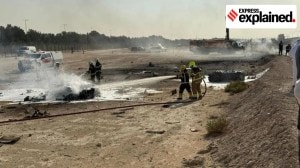CLIMATE CHANGE: ITS WORSE THAN WE FEARED
The shock came when the International Polar Year,a global consortium studying the Arctic,froze a small vessel into the sea ice off eastern Siberia in September 2006.
The shock came when the International Polar Year,a global consortium studying the Arctic,froze a small vessel into the sea ice off eastern Siberia in September 2006. Norwegian explorer Fridtjof Nansen had done the same thing a century before,and his Fram,carried by the drifting ice,emerged off eastern Greenland 34 months later. IPY scientists thought their Tara would take 24 to 36 months. But it reached Greenland in just 14 months,stark evidence that the sea ice found a more open,ice-free,and thus faster path westward thanks to Arctic melting.
The loss of Arctic sea ice is well ahead of what the Intergovernmental Panel on Climate Change forecast,largely because emissions of carbon dioxide have topped what the panelwhich foolishly expected nations to care enough about global warming to do something about itprojected. The models just arent keeping up with the reality of CO2 emissions,says the IPYs David Carlson. Although policymakers hoped climate models would prove to be alarmist,the opposite is true,particularly in the Arctic.
The IPCC may also have been too cautious on Greenland,assuming that the melting of its glaciers would contribute little to sea-level rise. Some studies found that Greenlands glacial streams were surging and surface ice was morphing into liquid lakes,but others made a strong case that those surges and melts were aberrations,not long-term trends. It seemed to be a standoff. More reliable data,however,such as satellite measurements of Greenlands mass,show that it is losing about 52 cubic miles per year and that the melting is accelerating. So while the IPCC projected that sea level would rise 16 inches this century,now a more likely figure is one meter (39 inches) at the least, says Carlson. Chest high instead of knee high,with half to two-thirds of that due to Greenland. Hence the no idea how bad it was.
The frozen north had another surprise in store. Scientists have long known that permafrost,if it melted,would release carbon,exacerbating global warming,which would melt more permafrost,which would add more to global warming,on and on in a feedback loop. But estimates of how much carbon is locked into Arctic permafrost were,it turns out,woefully off. Its about three times as much as was thought,about 1.6 trillion metric tonnes,which has surprised a lot of people, says Edward Schuur of the University of Florida. It means the potential for positive feedbacks is greatly increased. That 1.6 trillion tons is about twice the amount now in the atmosphere. And Schuurs measurements of how quickly CO2 can come out of permafrost,reported in May,were also a surprise: 1 billion to 2 billion tonnes per year. Cars and light trucks in the U.S. emit about 300 million tonnes per year.
In an insightful observation in The Guardian this month,Jim Watson of the University of Sussex wrote that a new breed of climate sceptic is becoming more common: someone who doubts not the science but the policy response. Given the pathetic (non)action on global warming at the G8 summit,scepticism that the world will get its act together seems appropriate. For instance,the G8,led by Europe,has vowed to take steps to keep global warming below 2 degrees Celsius by reducing CO2 emissions. Were now at 0.8 degree. But the amount of CO2 in the atmosphere is already enough to raise the mercury 2 degrees. The only reason it hasnt is that the atmosphere is full of crap (dust and aerosols that contribute to asthma,emphysema,and other diseases) that acts as a global coolant. As that pollution is reduced for health reasons,were going to blast right through 2 degrees,which is enough to exacerbate droughts and storms,wreak havoc on agriculture,and produce a planet warmer than its been in millions of years. The 2-degree promise is a mirage.
The test of whether the nations of the world care enough to act will come in December,when 192 countries meet in Copenhagen to hammer out a climate treaty. Carlson vows that IPY will finish its Arctic assessment in time for the meeting,and one conclusion is already clear. A consensus has developed during IPY that the Greenland ice sheet will disappear, he says.
- 01
- 02
- 03
- 04
- 05































